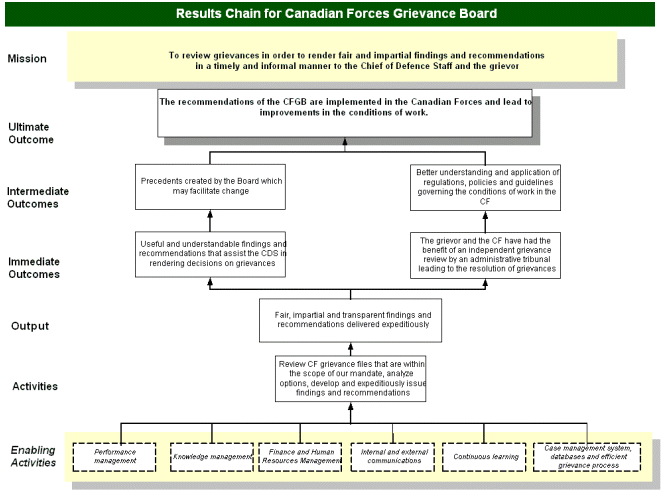Common menu bar links
Breadcrumb Trail
ARCHIVED - RPP 2007-2008
Canadian Forces Grievance Board
 This page has been archived.
This page has been archived.
Archived Content
Information identified as archived on the Web is for reference, research or recordkeeping purposes. It has not been altered or updated after the date of archiving. Web pages that are archived on the Web are not subject to the Government of Canada Web Standards. As per the Communications Policy of the Government of Canada, you can request alternate formats on the "Contact Us" page.
SECTION II – ANALYSIS OF PROGRAM ACTIVITIES BY STRATEGIC OUTCOME
Analysis by Program Activity
Strategic Outcome:
The recommendations of the Canadian Forces Grievances Board are implemented in the Canadian Forces and lead to improvements in the conditions of work.
Program Activity: Review of Canadian Forces grievances referred by the Chief of the Defence Staff.
Financial Resources:
($ thousands)
| 2007-2008 | 2008-2009 | 2009-2010 |
|---|---|---|
| $3,348 | $3,348 | $3,348 |
Human Resources:
| 2007-2008 | 2008-2009 | 2009-2010 |
|---|---|---|
| 28 | 28 | 28 |
Program Activity: Internal Services (Corporate and Administrative Services)
Financial Resources:
($ thousands)
| 2007-2008 | 2008-2009 | 2009-2010 |
|---|---|---|
| $3,081 | $3,081 | $3,081 |
Human Resources:
| 2007-2008 | 2008-2009 | 2009-2010 |
|---|---|---|
| 18 | 18 | 18 |
The Board conducts objective and transparent reviews of grievances with due respect to fairness and equity for each member of the CF, regardless of rank or position. It ensures that the rights of military personnel are considered fairly throughout the process and that its Board Members act in the best interest of the parties concerned. The findings and recommendations it issues are not only based in law but form precedents that may facilitate change within the CF. Administrative tribunals, such as the Board, provide a mechanism outside the courts for the expeditious resolution of complex and particular matters. Acting independently of the government, tribunals have the power to make decisions through enabling statutes of Parliament. Such powers permit the tribunal to determine the existence and scope of rights and obligations in a particular field of expertise. These powers are to be exercised in accordance with the public interest and the specific circumstances prevailing in the tribunal's area of activity.
As an administrative tribunal designed to review grievances, the Board must ensure that its recommendations comply with the law and can be implemented in accordance with its enabling legislation, relevant human rights legislation and the Canadian Charter of Rights and Freedoms. Canadian courts have also rendered several decisions on a wide range of subjects and Board Members must keep abreast of these, as well as the current Queen's Regulations and Orders for the Canadian Forces (QR&O), the Canadian Forces Administrative Orders (CFAO) and Treasury Board policies, all of which are used in the course of analyzing grievances and developing findings and recommendations.
Expected Results
The Board's Results Chain or Logic Model demonstrates how each of the items contributes to the fulfillment of the Board's mission and the achievement of its ultimate or strategic outcome.
Logic Model
 Click to view a larger version of this graphic
Click to view a larger version of this graphic
Performance Measurement Strategy
| Planned outcomes and results | Performance Indicators |
|---|---|
|
Outputs:These are the outputs produced and the benefits to the CDS, who makes a decision on the basis of the recommendations submitted by the Board, and the grievor, who is the ultimate beneficiary of the decision rendered by the CDS. |
|
| Fair, impartial and transparent findings and recommendations delivered expeditiously. |
|
| Immediate Outcome: These are the short-term results of the Board's activities and its output. | |
| Useful and understandable findings and recommendations that assist the CDS in rendering decisions on grievances. |
|
| The grievor and the CF have had the benefit of a grievance review by an independent quasi-judicial tribunal leading to the resolution of grievances. | |
| Intermediate Outcomes: These are the longer term results, i.e., about 5 years, that flow from its activities, outputs and immediate outcomes, and which will demonstrate progress towards achieving CFGB's ultimate result. | |
| Precedents created by the Board, which may facilitate change. | CDS decisions to address systemic issues raised by the CFGB that merit further study for possible policy or regulatory change. |
| Better understanding and application of regulations, policies and guidelines governing the conditions of work within the CF. | Reduction of grievances of the same nature. |
| Ultimate Outcome: This is the long-term result that logically flows from the work conducted by the Board, and it is expected that it will take about 10 years before seeing substantial evidence of this result. It is to be noted that the achievement of this ultimate result may be subject to influences beyond CFGB's work. | |
| The Recommendations of the CFGB are implemented in the Canadian Forces and lead to improvements in the conditions of work. | CFGB’s recommendations for changes to regulations, policies or procedures have been implemented by the Canadian Forces. |
| Enabling Activities: Internal Services (Corporate and Administrative Services) function includes a wide range of activities that support the Board's outcomes. Internal Services (Corporate and Administrative Services) works for continuous improvement in the provision of timely and quality corporate administrative services, and in the promotion of sound management. |
|
